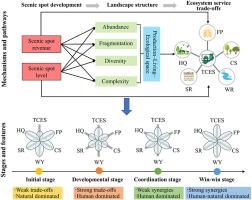Trade-offs, synergies and driving pathways between tourism cultural ecosystem service and multiple ecosystem services in ecological functional zone
IF 7
1区 经济学
Q1 DEVELOPMENT STUDIES
引用次数: 0
Abstract
Tourism cultural ecosystem service (TCES) is crucial for promoting sustainable development in ecological functional zones, which face the dual challenge of conservation and livelihoods. However, the spatial and temporal interactions between TCES and other ecosystem services (ESs) are not yet fully understood. This study aims to address this gap by quantifying the trade-offs between TCES and five key ESs, while also identifying the impact pathways of these trade-offs. The Taihang Mountains were selected as a case study, using multisource data and structural equation modeling for analysis. The results indicated that between 2000 and 2020, the area of living space around scenic spots increased by 59.22 %, primarily due to encroachments into production and ecological spaces, leading to greater fragmentation. During this period, TCES, food production (FP), carbon storage (CS), and soil retention (SR) all increased by 7.14 %, 31.79 %, 78.68 %, and 26.13 %, respectively. However, water yield (WY) and habitat quality (HQ) decreased by 5.44 % and 0.33 %, respectively. TCES showed significant synergies with HQ, SR, and CS, especially in the southeastern part of the study area. In contrast, trade-offs were observed between FP and WY, primarily in the northern region. Notably, in 2010, revenue from scenic spots had a significant impact on the TCES–FP trade-off, as it intensified ecological space fragmentation and expanded production areas. By 2020, however, the level of development at scenic spots became a key factor in fostering synergies between TCES and CS, driven by increased landscape diversity and further fragmentation of living spaces. These findings provide important insights for the sustainable management and planning of landscapes in ecological functional areas, emphasizing the role of TCES in balancing conservation with development.

生态功能区旅游文化生态系统服务与多种生态系统服务的权衡、协同效应及驱动路径
旅游文化生态系统服务是促进生态功能区可持续发展的关键,生态功能区面临着保护和生计的双重挑战。然而,TCES与其他生态系统服务之间的时空相互作用尚不完全清楚。本研究旨在通过量化TCES与五个关键ESs之间的权衡来解决这一差距,同时确定这些权衡的影响途径。以太行山为例,采用多源数据和结构方程模型进行分析。结果表明:2000 - 2020年,景区周边生活空间面积增加59.22%,主要是生产空间和生态空间受到侵蚀,破碎化程度加大;在此期间,TCES、粮食产量(FP)、碳储量(CS)和土壤保有量(SR)分别增加7.14%、31.79%、78.68%和26.13%。产水量(WY)和生境质量(HQ)分别下降5.44%和0.33%。TCES与HQ、SR和CS具有显著的协同效应,特别是在研究区的东南部。相比之下,计划生育和WY之间存在权衡,主要是在北部地区。值得注意的是,2010年景区收入对TCES-FP权衡产生了显著影响,加剧了生态空间破碎化,扩大了生产区域。然而,到2020年,在景观多样性增加和居住空间进一步碎片化的驱动下,景区的发展水平成为促进TCES和CS之间协同效应的关键因素。这些发现为生态功能区景观的可持续管理和规划提供了重要的见解,强调了生态功能区在平衡保护与发展方面的作用。
本文章由计算机程序翻译,如有差异,请以英文原文为准。
求助全文
约1分钟内获得全文
求助全文
来源期刊

Habitat International
Multiple-
CiteScore
10.50
自引率
10.30%
发文量
151
审稿时长
38 days
期刊介绍:
Habitat International is dedicated to the study of urban and rural human settlements: their planning, design, production and management. Its main focus is on urbanisation in its broadest sense in the developing world. However, increasingly the interrelationships and linkages between cities and towns in the developing and developed worlds are becoming apparent and solutions to the problems that result are urgently required. The economic, social, technological and political systems of the world are intertwined and changes in one region almost always affect other regions.
 求助内容:
求助内容: 应助结果提醒方式:
应助结果提醒方式:


